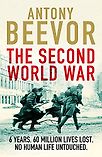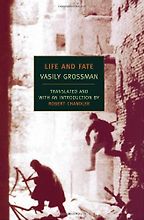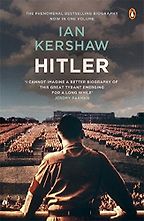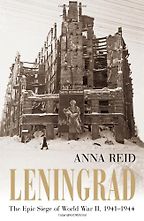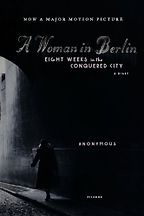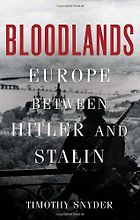You have won numerous awards, sold millions of copies of your books and had them translated into lots of different languages. But I was wondering, which historians inspire you?
The very first historian to inspire me was John Keegan, who I studied under at Sandhurst, because he wrote The Face of Battle, which was one of the key moments in the turning points of military history. Up until then military history had usually been written by retired officers or generals, trying to make out that commanders were chess grandmasters playing some brilliant game, when in fact it was all chaos and fear and smoke. It was the first time that military history had been written as history from below.
Then, interestingly, there was a period afterwards when suddenly oral history started to become fashionable. I was always rather dubious about oral history because I felt it had no proper context. From my point of view John Keegan’s book was the greatest influence because it pushed me in the direction where I was eventually heading, of trying to integrate history from above with history from below.
What is it that makes you particularly interested in World War II?
To start off with I was particularly interested in the Napoleonic Wars and I will eventually go back to them when, for me, World War II is finally over. But World War II continues to be the most important war in history because of the effect that it had on so many people’s lives and on so many countries.
The most important lesson I ever learned came to me in the French archives when I was researching a book about Paris after the liberation. After six months of waiting for permission from the Ministry of the Interior I came across this report from the security police describing how a German woman had been found in Paris in the summer of 1945. In fact it was a German farmer’s wife who had fallen desperately in love with a French prisoner of war who had been working on their farm and she’d followed him back to France by smuggling herself on to the train carrying deported prisoners back to France. That suddenly raised so many other questions for me. We always think about those who have died and the casualties of war without fully appreciating how the decisions of Stalin or Hitler changed everybody’s lives.
The first book you’ve chosen is a novel by someone whose work you know very well indeed – the Russian writer Vasily Grossman. You edited his war notes. But this is his novel, Life and Fate, which was considered highly controversial and banned in Russia.
Yes, the manuscript was confiscated when it had just been written in 1960. The KGB came into his apartment and then went to his secretary’s apartment, and confiscated even the typewriter ribbons and the carbon papers because the novel was regarded as so dangerous.
Why was that?
Grossman was the very first person to make the moral equivalence between Nazism and Stalinism. It was that which was so devastating. He quite clearly indicated that Stalin had been responsible for the appalling disasters of the early part of the war and for the repression that came through towards the end of the war. What is interesting about Grossman is that he is one of the few examples where you get both physical courage and moral courage in the same person. That is very rare – normally moral courage and physical courage are two separate things and don’t exist together.
How did he show physical courage?
He showed physical courage as a slightly middle-aged, totally unfit, Jewish intellectual from Moscow going into the front line with the Red Army and living the same life alongside many of the soldiers. This is where he got his material. He was obviously not one of the Stalinist hacks who came out with preposterous propaganda. The soldiers had read his stuff in the Red Star, the army newspaper, and they knew that he was about the only honest one. And he wouldn’t take any notes. He would just sit down beside them and then write up the notes afterwards, because he knew perfectly well that if he sat down with a pad that would switch them off. And he used to work incredibly long hours into the night writing up all the conversations that he had had.
These were the notebooks that we worked on in Moscow and one realised that here was most of the raw material for Life and Fate which I think is probably the most important work of fiction about World War II. But, in fact, it is more than just a fiction because it is based on very close reporting from his time with the soldiers. It is a deliberate act of literary homage to Tolstoy as one can see in the title. It is definitely the War and Peace of the 20th century.
Your next choice is a two-volume biography of Hitler by Ian Kershaw.
Ian Kershaw is a totally admirable historian. He is absolutely scrupulous. He does incredible research. His books have superb scholarship and breadth of knowledge as a result. But, above all, he has a clarity of thought and a clarity of prose which is not merely enviable but should be followed by any sort of academic historian who wants to know how to write and how to reach a wider audience and also to remain a completely scholarly source.
His biography very much relies on primary sources.
Yes, indeed, and he knows them almost better than anyone. I don’t think that any historian should ever accept that a book is definitive. Nothing is definitive. But I don’t see Kershaw’s work on Hitler really ever being surpassed.
What did his book teach you about Hitler?
So much of it is in the detail rather than overall. One sees so much written about Hitler that just churns out the same sort of stuff. Where Kershaw is so judicious and magisterial is that he manages to put details and, above all, Hitler’s words into a much wider context. One sees the implications particularly when it comes to the difficulties of a setting and the exact progress towards the Final Solution. For example, he looks at the decision about when to launch the Holocaust or the Shoah by gas, as Grossman called it, which is one of the key areas of debate amongst historians. And Kershaw’s assessment is probably the most reliable and accurate of all.
What is his assessment?
In his book he defines “the Final Solution to the Jewish question” as “the systematic [Nazi] attempt to exterminate the whole of European Jewry”. And this is the traditional view and the one currently accepted by mainstream historians. Kershaw goes on to state the three major questions that, in his view, surround the Final Solution. They are: How and when the decision to exterminate the Jews came about; what was Hitler’s role in this policy of mass murder, and whether the Final Solution followed a single order from a long-held programme or evolved in a haphazard and piecemeal fashion over a period of time?
After posing these questions, he concludes: “The deficiencies and ambiguities of the evidence, enhanced by the language of euphemism and camouflage used by the Nazis, even among themselves when dealing with the extermination of the Jews, mean that absolute certainty in answering these complex questions can not be achieved.” He is saying there is room for doubt in regard to the answers mainstream historians have given to the previous questions.
Your next book takes us to a part of World War II in which you have a particular interest. Leningrad by Anna Reid reveals the Nazis’ deliberate decision to starve the city of Leningrad into surrender.
This was the longest and most devastating siege in the history of World War II. Hitler was determined to take over the Russian city for symbolic reasons, and during the two-and-a-half-year siege 750,000 civilians were deliberately starved to death. This amounted to a quarter of Leningrad’s population. Much has been written about Leningrad in the past. One famous book is The 900 Days: The Siege of Leningrad by Harrison Salisbury, and although it is excellent there weren’t any archives open at that particular stage so he was limited by what he could obtain through official sources in Leningrad. It is still a remarkable book.
But Anna Reid’s book goes far further because, with excellent research in archives which weren’t available before, she is able to show how totally cynical Stalin’s attitude was to Leningrad. Indeed it was a major factor in the appalling loss of life and suffering, which is very hard to appreciate. When I was researching my own book Stalingrad, and for years afterwards, I couldn’t look at a plate of food without thinking what that would have meant to about a dozen people in Stalingrad. In Leningrad it was even worse. There are photographs, for example, of the same woman taken just a few months apart for her identity documents and in a matter of months she has become an old hag, even though she started off as a rather plump young woman. So the effects of starvation on a whole society is indeed worth studying and I think that Anna Reid has done it brilliantly. Another interesting aspect of her book is her exploration of the extent to which people living in Leningrad had to resort to cannibalism in order to survive.
You mentioned that Stalin had a cynical attitude towards Leningrad. What does Anna Reid’s book reveal he did to his own people?
The problem was that Stalin failed to evacuate Leningrad before the siege ring closed and he made little attempt to stockpile extra food when it was still possible. As starvation set in, inhabitants began to boil calfskins for hoped-for nutrition or eat joiner’s glue made from the bones and hooves of slaughtered livestock. At the height of the German advance on Moscow, Stalin was even prepared to withdraw all troops from Leningrad and abandon the city to a terrible fate. He had always distrusted Leningrad as a city of intellectuals and lovers of Western influences, which made them tantamount to traitors in his eyes.
That is an interesting aspect to World War II you don’t often hear about. You are obviously famous for your book Stalingrad – can you explain why that was another key moment in the war?
Stalingrad was the psychological turning point of the war. It took place between 23 August 1942 to 2 February 1943 and it was the largest battle on the Eastern Front. Nazi Germany and their allies were fighting for control of the city of Stalingrad in southwest Russia. The geopolitical turning point of the war came slightly earlier, even though people didn’t really recognise it at the time. It was in December 1941, when the German armies were repulsed in front of Moscow and Hitler decided to declare war on the United States after Pearl Harbor. But Stalingrad was vital in its own particular way because the Red Army for the first time held its ground in the city, fighting in desperate circumstances. Also, its new commanders had the foresight to do what they felt was necessary rather than being terrified of being arrested for their actions, which was the case in the earlier part of the war.
Two Soviet generals, Georgy Zhukov and Aleksandr Vasilevsky, came up with this plan to encircle the whole of the Sixth Army, which was incredibly ambitious. The Germans saw that it was a possibility but they simply did not believe that the Red Army was capable of carrying it out. And the very fact of achieving that meant that the whole psychology of the war, not just in the Soviet Union but elsewhere as well, led to this belief that finally the Germans were beaten and the Allies could win. As far away as Chile the poet Pablo Neruda wrote his homenaje a Stalingrado – so Stalingrad had this tremendous effect on the resistance throughout the world. Stalingrad itself was a byword for courage and it was also a byword for suffering.
This is really what I was trying to do when I researched the Russian military archives. I wanted to find out the detail of what life was like for the soldiers and it was simply terrifying. They executed 13,000 of their own men during the course of the battle, which is something that we simply could not imagine.
Why did they do that?
Because they were so afraid of them breaking. Anyone who retreated without orders was executed.
So much about history focuses on the politics and the people in power but your next choice tells the very personal story of a young woman who preferred to remain anonymous, living in Berlin in 1945, who kept a daily record of her life.
This book, A Woman in Berlin, is one of the great diaries of the whole war. Although it was published anonymously we do know the name of the woman who wrote it now. She was called Marta Hillers and she was an extremely intelligent journalist who had travelled quite a lot before the war and was certainly not a Nazi. She was extremely open-minded and it was her enquiring mind and observation which really showed the reality of the Soviet attack on Berlin in April 1945 through to the beginning of May.
There is the whole question of the mass rapes by the Red Army. This is a very controversial subject, as I know only too well. Her account is so patently well observed of what was going on. There is no self-pity, even though she herself was raped on numerous occasions. Through her you see the reality of life and war for civilians in those sorts of circumstances. There is this need of unity, particularly among the women, in order to survive. They manage to surmount their appalling experiences by being able to talk to each other.
And then, of course, they found their menfolk when they returned from the war simply couldn’t face up to the reality that they had not been able to protect their women. And one saw a fascinating but dismaying gender divide in that particular way. In many ways it was the women who were morally far stronger than the men. She describes how the role of the women is to support all these fragile men and basically massage their egos because otherwise they will go to pieces.
Your final choice is Bloodlands by Timothy Snyder.
This book is about not just World War II but it is also about the Stalinist repression of the areas known as the borderlands, which Snyder has termed the ‘bloodlands.’ Snyder is looking at the deliberate mass murder of civilians in a particular zone of Europe between about 1930, at the start of the second Ukraine famine, and 1945. The zone is the territory that lies between central Poland and, roughly, the Russian border, covering eastern Poland, Ukraine, Belarus and the Baltic republics. It is a remarkable work, not just of scholarship and research but, above all, of a fresh angle on the way that the inter-reaction between Nazism and Stalinism actually caused such appalling levels of hatred and murder in this particular area.
For example, the great famine in the Ukraine in the early 1930s was blamed on the Jews by the communists. They created rumours to indicate that it was the Jews who had been responsible for the famine when it had been the communist authorities themselves. And this fuelled a sort of latent anti-Semitism within the Ukraine. So, of course, when the Germans arrived, hundreds of thousands of Ukrainians, who actually served the Germans both as volunteers in the army but also as concentration camp guards, gave the extra impetus to the terrible massacres that took place.
One of the themes of the book is the power of propaganda which was used throughout World War II.
Yes, and even from before. I think that Goebbels was a diabolical genius. He saw that hatred was not enough and you had to combine hatred with fear if you were going to get the maximum killing potential out of your followers. Snyder, in this extraordinary book, shows how some 14 million people were killed in this particular region, which basically runs from Eastern Germany all the way though to Eastern Belarus and the Ukraine as well as the Baltic States, Poland and Hungary into the Balkans. These were the areas where most of the Jews lived who had suffered in the Holocaust but also where the Nazis positioned their extermination camps. The borderlands were the most blood-soaked regions of World War II.
What particular aspects of the war does your book, The Second World War, focus on?
In a way the book has not a very admirable genesis. I became more and more conscious that I had concentrated on certain areas of World War II and I always felt a bit of a fraud being billed as the great expert because I knew perfectly well that there were certain areas of which I knew nothing! And I also realised how important it was to bring the whole thing together. For example, I start with the Battle of Khalkhyn Gol on the Manchurian Mongolian border in 1939. This was a battle between the Soviets and Japan and it was one of the most influential battles in the whole of World War II. You have all of these knock-on effects between the Pacific War and the European War and that was what prompted me to write the book.
June 1, 2019. Updated: December 10, 2024
Five Books aims to keep its book recommendations and interviews up to date. If you are the interviewee and would like to update your choice of books (or even just what you say about them) please email us at [email protected]
Support Five Books
Five Books interviews are expensive to produce. If you've enjoyed this interview, please support us by donating a small amount.

Antony Beevor
Antony Beevor is an English military historian. He is a former officer with the 11th Hussars, who served in England and Germany for five years before resigning his commission. He has published several popular histories on the Second World War and the 20th century in general.

Antony Beevor
Antony Beevor is an English military historian. He is a former officer with the 11th Hussars, who served in England and Germany for five years before resigning his commission. He has published several popular histories on the Second World War and the 20th century in general.

